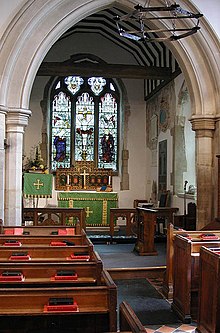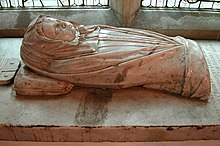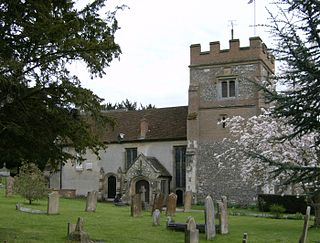
Harefield is a village in the London Borough of Hillingdon, England, 17 miles (27 km) northwest of Charing Cross near Greater London's boundary with Buckinghamshire to the west and Hertfordshire to the north. The population at the 2011 Census was 7,399. Harefield is the westernmost settlement in Greater London, and lies outside the capital's contiguous built-up area.

Ickenham is an area in Greater London, forming the northern part of Uxbridge and within the London Borough of Hillingdon.

Northwood is an area in the London Borough of Hillingdon, located 14.5 miles (23.3 km) north-west of Charing Cross. Northwood was part of the ancient parish of Ruislip, Middlesex. The area was situated on the historic Middlesex boundary with Hertfordshire, and since being incorporated into Greater London in 1965, has been on the Greater London boundary with that county.

Ruislip is an area in the London Borough of Hillingdon in West London. Prior to 1965 it was in Middlesex. Ruislip lies 13.8 miles (22.2 km) west-north-west of Charing Cross, London.

South Ruislip is an area of west London in the London Borough of Hillingdon, south-east of Ruislip, south of Eastcote, north-west of Northolt, and west of South Harrow. A 2017 estimation put the population of South Ruislip ward as 13,150 residents.

Hillingdon is an area of Uxbridge within the London Borough of Hillingdon, centred 14.2 miles (22.8 km) west of Charing Cross. It was an ancient parish in Middlesex that included the market town of Uxbridge. During the 1920s the civil parish bore a rapid, planned increase in population and housing, and was absorbed by Uxbridge Urban District in 1929. It has formed part of Greater London since 1965.
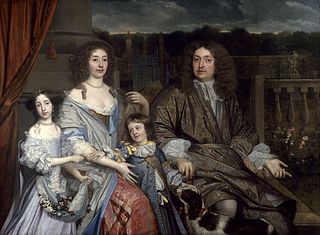
Sir Robert Vyner, 1st Baronet was an English banker, goldsmith and Lord Mayor of London.

Ruislip Manor is an area of Ruislip in the London Borough of Hillingdon in West London. It is located approximately 13 miles (20.9 km) west north west of Charing Cross.
Vyners School is a secondary school and sixth form in Ickenham within the London Borough of Hillingdon. Since November 2011 the school has had an academy status.
John Pritchett was an English churchman, bishop of Gloucester from 1672.

Ruislip Woods is a Site of Special Scientific Interest and national nature reserve covering 726 acres (294 ha) in Ruislip in the London Borough of Hillingdon. The woods became London's first national nature reserve in May 1997. Ruislip Local Nature Reserve at TQ 090 899 is part of the national nature reserve.
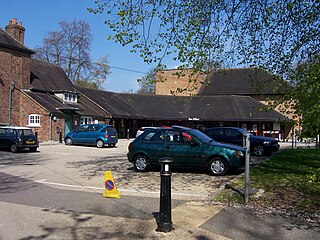
The Compass Theatre is a 158-seat theatre in Ickenham owned by the London Borough of Hillingdon.

Manor Farm is a 22-acre (8.9 ha) historic site in Ruislip, Greater London. It incorporates a medieval farm complex, with a main old barn dating from the 13th century and a farm house from the 16th. Nearby are the remains of a motte-and-bailey castle believed to date from shortly after the Norman conquest of England. Original groundwork on the site has been dated to the 9th century.

Swakeleys House is a Grade I-listed 17th-century mansion in Ickenham, London Borough of Hillingdon, built in 1638 for the future Lord Mayor of London, Sir Edmund Wright. Originally the home of the lords of the manor of Swakeleys, writer Samuel Pepys visited the house twice. The property changed hands many times over the years and at one time was home to the Foreign & Commonwealth Office Sports Association. Large sections of the grounds were sold off in 1922 and developed as suburban housing.

Highgrove House, also known as High Grove House or High Grove, is a Grade II listed mansion in the suburban area of Eastcote, within the London Borough of Hillingdon. Originally built in 1750 by the Reverend John Lidgould, the house was rebuilt in 1881 by Sir Hugh Hume-Campbell following a catastrophic fire. Along with Haydon Hall and Eastcote House, Highgrove was one of the three main houses of Eastcote and eventually became a residential hostel for homeless families, run by the local council from the 1960s until 2007. An area of the estate was sold to the local council in 1935 by the then-owner Eleanor Warrender to become what is now Warrender Park. In 1975, the house was granted Grade II listed status on account of its special architectural character.

St Martin's Church is a church in the west London town of Ruislip, within the London Borough of Hillingdon. It has been designated since January 1950 by English Heritage as a Grade I listed building. The present chancel and nave date back to the 13th century. The church stands at the northern end of Ruislip High Street, near the Manor Farm site.

Sir Edmund Wright was an English merchant who was Lord Mayor of London in 1640.
Robert Vyner (1686–1777) of Swakeleys, Middlesex, and Gautby, Lincolnshire, was a British politician who sat in the House of Commons for 27 years between 1710 and 1761.


